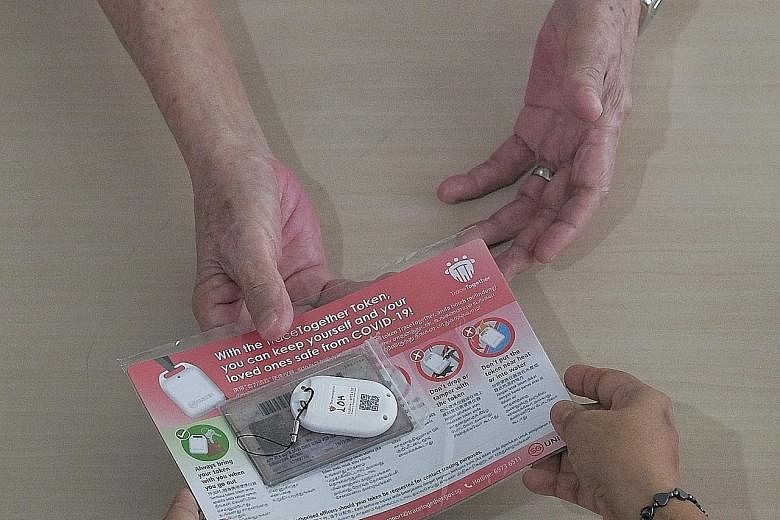While the Government has made it known that TraceTogether data may be tapped under the Criminal Procedure Code for investigations into serious offences, the operational reason for doing so has not been offered.
What is known is that the Government plans to introduce a new law today to specify that personal data collected through digital contact tracing solutions, which comprise the TraceTogether and SafeEntry programmes, can be used for only contact tracing, but with an exception - when there is a "clear and pressing" need to use that data for investigations into seven serious offences including murder, terrorism and rape.
Reports from overseas might offer a clue to the need for the new law - face coverings, made mandatory amid the Covid-19 pandemic, have resulted in a decline in the efficacy of security cameras, including those which use technologies driven by artificial intelligence (AI), such as facial recognition.
In the United States, a government agency reported last July that facial recognition algorithms used by AI cameras were misidentifying people wearing face coverings, with error rates as high as 50 per cent.
US media reports showed criminals have capitalised on face coverings to hide their identity.
EFFICACY OF POLCAMS
To be clear, the authorities in Singapore have access to, and tapped various sources of information in tackling law and order issues here. For instance, the police work with banks, which flag unusual transactions and block transfers to protect unsuspecting clients from being the victims of scams. There are also online platforms, such as i-Witness, to enable the public to discreetly provide information in a criminal investigation.
The police also rely on the tens of thousands of police cameras (PolCams) that have been installed since 2012. As at end-2017, footage from these cameras have helped solve more than 2,300 cases, including theft and molestation. Housing Board blocks fitted with cameras also saw fewer unlicensed moneylending harassment cases.
But with mandatory face coverings, the police will need to supplement their intelligence gathering, and TraceTogether data may offer information at critical junctures.
While it is a stretch to imagine data from the programme alone could lead to crime solving, the mandatory use of the app or token for entry into public venues by more than 4.2 million participants, or about 78 per cent of residents here, means the police have a wider pool of information they can draw on when all else fails in cracking serious crimes.
USE OF I.T. FOR SECURITY
Technology has shaped the history of criminal investigations. Breakthroughs such as finger printing and DNA testing have helped bring about justice and closure to countless people.
So when new technology comes along that could be added to the crime-busting toolkit, they should not be dismissed on first sight. The fact of their availability can make a great deal of difference.
Consider the case of the Little India riots, which was cited by Prime Minister Lee Hsien Loong when he made the case in 2017 for greater use of information technology (IT) to enhance public safety and security.
In outlining a plan to build an integrated national sensor network comprising, among other things, 95,000 "smart" lamp posts and AI technology to analyse video footage collected by government agencies, PM Lee said the additional information could help the authorities to respond promptly, or even pre-emptively, in case of emergencies.
This would avoid a repeat of the chaos and security shortcomings of the 2013 Little India riots, when more than 400 people went on a rampage, attacking police and Singapore Civil Defence Force officers responding to a fatal traffic accident near Tekka Lane. PM Lee noted that a lack of data then caught the authorities flat-footed. "There were too few CCTV cameras monitoring Little India. We had to rely on footage posted by the public on social media."
The security cameras old and new are placed in housing estates and high foot traffic areas such as town centres and linked walkways.
But the efficacy of this network in fighting not just major outbreaks of crime, but relatively smaller ones such as theft and assault, has been compromised by the mask mandate.
SAFETY VERSUS PRIVACY
Privacy concerns in the use of TraceTogether data in criminal investigations were recently raised in Parliament, an issue that had been flagged in 2018 over data collected by PolCams.
In its reply then, the Government spelt out data protection safeguards which the police employ and the controls put in place on access to such data.
The Government also cited survey findings in which respondents indicated that cameras had contributed to their perception of feeling safer. This mirrored the findings in a 2014 survey by multinational professional services company Accenture, which reported that Singaporeans were comfortable with the police using predictive technologies (96 per cent of respondents) and security cameras (91 per cent).
Those with misgivings over the use of TraceTogether data for criminal investigations should consider how much they are prepared to give up in terms of security, in exchange for privacy.
They must also examine the paradox: That while raising privacy concerns over data collection, they are voluntarily giving up their personal information through searches on mobile phones and other devices, and through social media posts as well as online purchases with credit cards. Data brokers and big tech companies like Google and Facebook mine such information to feed their bottom line.
NOT BINARY OPTIONS
The argument for the use of TraceTogether in crime fighting is not about the dismissal of the importance of privacy concerns, but to avoid treating privacy and security as binary options.
Mr Muhammad Faizal Abdul Rahman, in the Lowy Institute's publication The Interpreter, calls for a balanced approach, with states assessing how they use surveillance tools even as they battle the virus and its socioeconomic impact, both of which are likely to linger for years.
"Covid-19 may be a turning point that causes states to make tougher choices to better prepare for both man-made and biological threats.
"Public health unpreparedness has already resulted in severe harm to national interests. Keeping people safe and economies functioning is fundamental for a state's political legitimacy," said the research fellow with the Centre of Excellence for National Security, a unit of the S. Rajaratnam School of International Studies.
But he added that states must also acknowledge that concerns over privacy and civil liberties will continue to characterise the "post-pandemic zeitgeist", and that states must also demonstrate how surveillance protects citizens, not only institutions and elites.
When the new law is introduced in Parliament, the Government needs to elaborate on the challenges it may be facing with mandatory face coverings and the role big data can play to keep people in Singapore safe.
Greater clarity on this will help foster public acceptance of technology that can fight both crime and the deadly virus.


